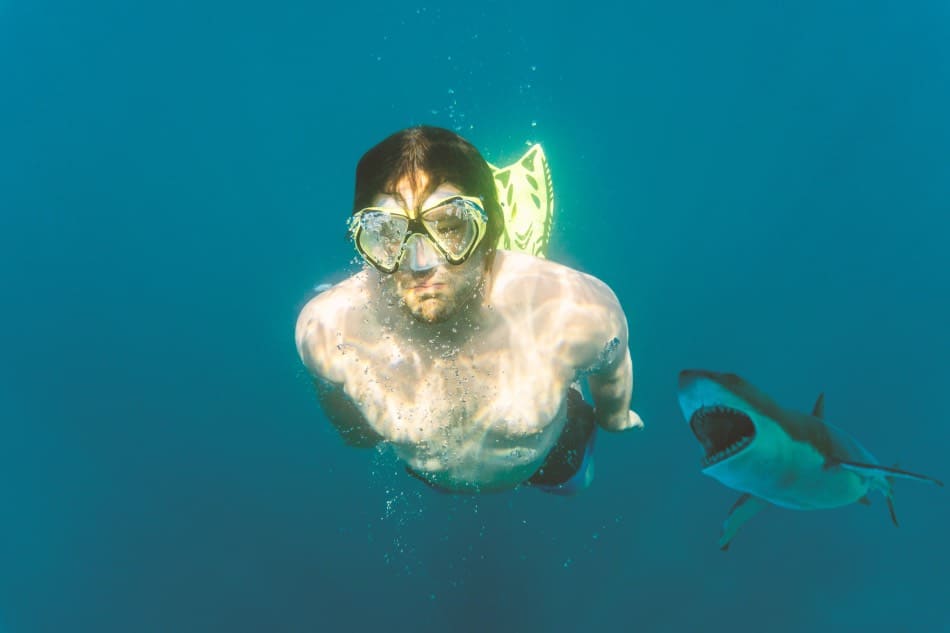What colors attract Sharks: Are red swimsuits Safe?
Every color under the sun, most shades of blue and green, are safe to use in waters where you don’t want sharks, but bright colors of reds and oranges will attract them.
This is because of how the texture and pigments in reds, yellows, and oranges reflect light. Red colors are often made up of a bright orange or yellow background with black lines.
Orange shades have blue hues in them and some black. Sharks like to patterns on objects that they can recognize as prey when hunting, which is why black and white stripes work.
Sharks see reds and orange colors in the same way that humans see black and white patterns—as an object to eat!
So, if you are a surfer who loves to spell out your name on the waves with blue body paint, you may want to do something different next time. If you are planning a trip to swim with sharks and thinking about using bright red or orange to attract them, think again.
These colors will scare sharks away! Luckily for us swimmers, sharks have evolved to be attracted to the same colors they see when searching for prey in murky water and from far away.
It is important to note that there are still reports of swimmers being attacked by sharks in waters where they are not supposed to be. After all, there is no simple answer as to what attracts a shark attack!
What are dangerous sharks attracted to?

Red is the prime magnet for sharks, especially bull sharks. They’ll come near a boat that has red paint on it. The same with fish guts; if you want to attract bull sharks, leave the tuna carcass out in the sun for a few days and then drop it over the side of your boat.
According to one report, night fishing boats used red lights because they attracted big game fish like tuna and marlin, but sharks came along, too.
An Australian diver left a videotape in the ocean and came back to return it three days later. In that time, six sharks came to look at the tape. One of them bumped into it.”What attracts shark is movement — not necessarily something bright,” says the director of the International Shark Attack File (ISAF).
Scientists offer two theories for shark attraction to red. One is that it’s because of the way sharks (probably mostly bull sharks) see and sense light at the back of their eyes.
Sharks “see” through a filter in front, as humans do with glasses or contacts.
Many sharks have extra light receptors, which may make them see the world in black and white except for reds and oranges.
According to a report by an oceanographer with the National Oceanic and Atmospheric Administration’s (NOAA) Office of Marine and Aviation Operations, sharks have dichromatic color vision, like many fish and birds.
The third receptor is so sensitive that it may be the source of the ‘extra-sensory perception’ sharks are supposed to have.
All marine fish contain retinaldehyde, which has been suggested as the spectral filter responsible for dichromatic color vision. Sharks have three retinaldehyde cones, while bony fishes (that lack a swim bladder) have two, and the majority of all vertebrates possess only one.
Sharks may see in black, white, and red because it helps them view living things more sharply under certain light conditions that are present where they live. The “red” part of a shark’s color perception may be why they are attracted to red objects.
Other scientists agree that many sharks react to things that can make them feel threatened or out of places, such as bright colors, shiny metal, or unnatural-looking objects in their environment.
Sharks are also attracted to the smell of blood and other bodily fluids. They can pick up a whiff from several miles away.” They’re like dogs.”
But scientists aren’t sure why.
If you watch the Discovery Channel, they’ll tell you that sharks are attracted to an oily substance in the blood.
They say that’s why shark attacks increase on cloudy or rainy days because many people don’t wear sunblock and get badly sunburned.
But shark researchers say not everyone agrees with this. No one really knows why sharks are attracted to the smell of blood and other bodily fluids.
It’s a combination of several things, including color, movement, smell, and metal in the water. The bottom line is that there is no simple answer as to what attracts sharks.
Is there a smell sharks don’t like?

Sharks have a perfect sense of smell and can detect the tiniest amounts of blood. Some sharks can even pick up the scent of your skin lotion or shampoo from hundreds of feet away because they smell slightly different than freshwater.
But it’s not true that all sharks hate the smell of coconut oil, as has been suggested in the past.
The idea that sharks hate this scent was based on a Japanese lab experiment conducted in the 1960s.
The researchers were trying to figure out how to protect divers from being attacked by sharks during cage-diving expeditions, so they exposed sharks to all kinds of scents and then placed them in a tank with a diver. The researchers found that if they put the scent of coconut oil in the water, it made the shark very aggressive.
But the problem is that there are no good controls.
You can’t just put regular water into an aquarium and assume sharks will ignore it; after all, they are smart animals, so they know there’s nothing in the water. When you’re doing experiments like this, “you have to think very carefully about controls.”
The researchers didn’t control for things like how much time had passed since the sharks last ate.
If a shark is hungry, studies have shown that it will hunt down prey and be much more aggressive than it would be after a big meal.
Eating makes sharks act as if they’re in attack mode, which can make them much more likely to attack or bite. So the researchers might have just been seeing what you’d expect from hungry animals exposed to an unfamiliar smell.
Of course, people still believe that coconut oil repels sharks anyway, and some surfers rub the oil all over their bodies before entering the water.






